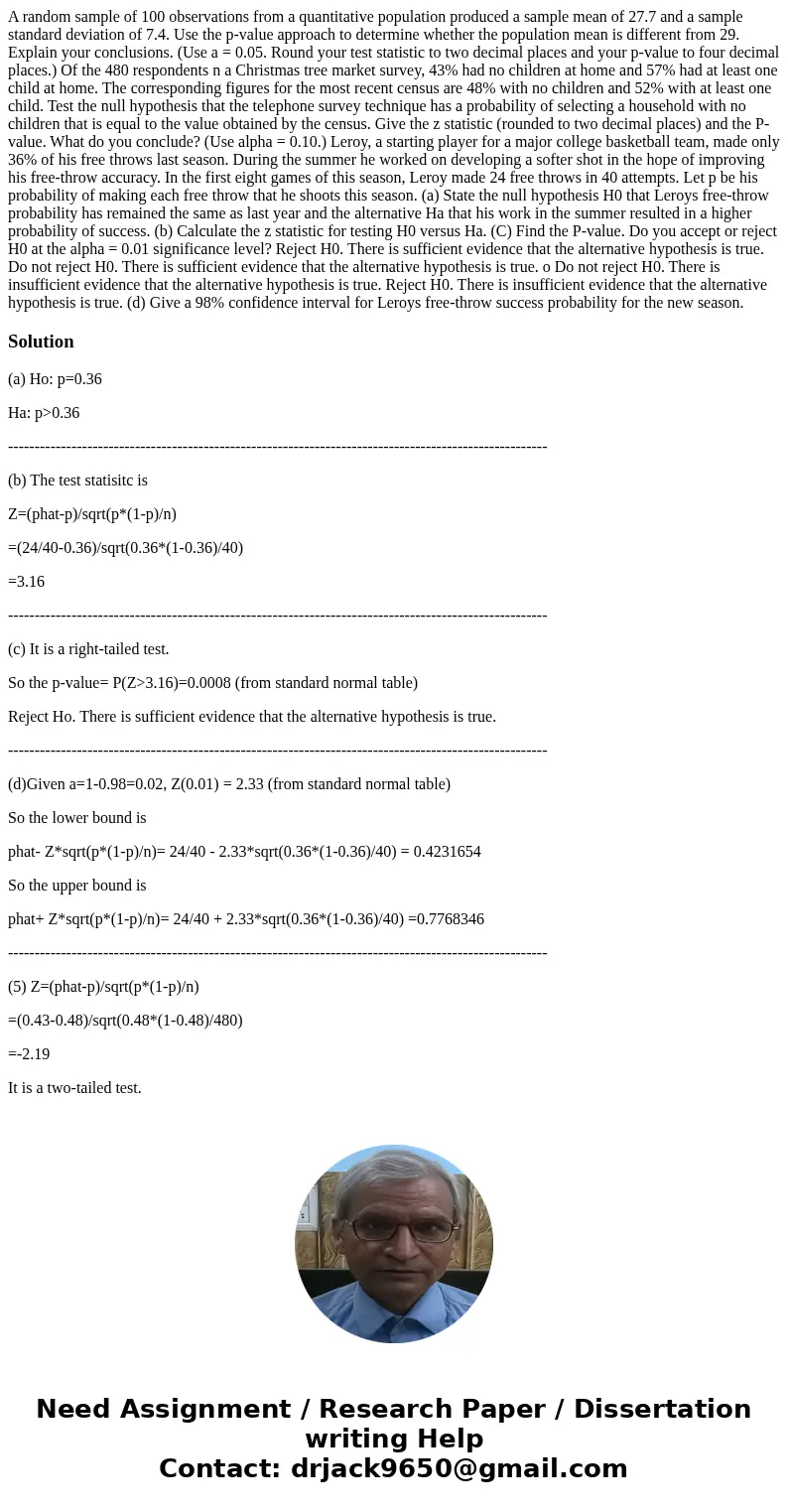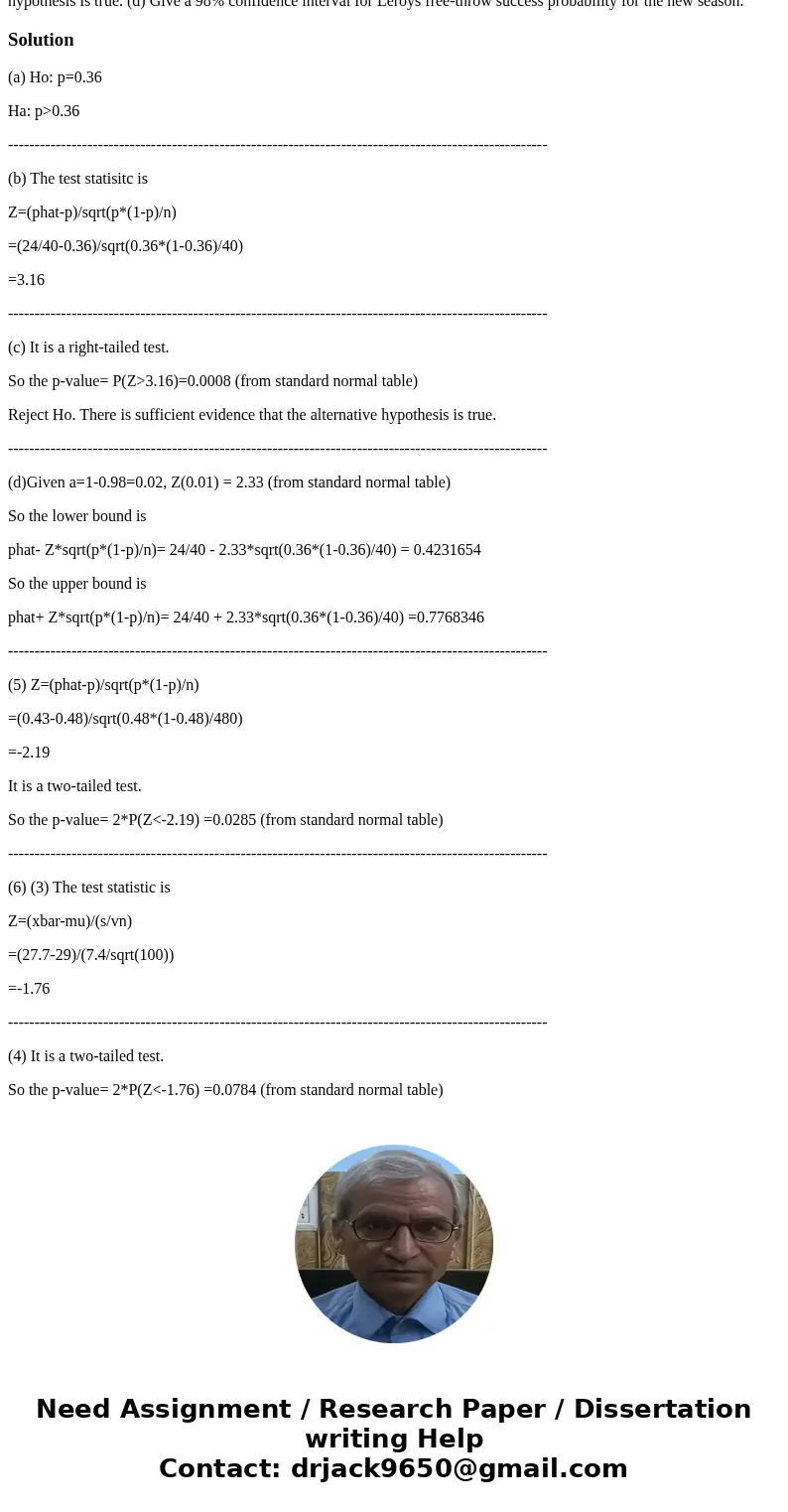A random sample of 100 observations from a quantitative population produced a sample mean of 27.7 and a sample standard deviation of 7.4. Use the p-value approach to determine whether the population mean is different from 29. Explain your conclusions. (Use a = 0.05. Round your test statistic to two decimal places and your p-value to four decimal places.) Of the 480 respondents n a Christmas tree market survey, 43% had no children at home and 57% had at least one child at home. The corresponding figures for the most recent census are 48% with no children and 52% with at least one child. Test the null hypothesis that the telephone survey technique has a probability of selecting a household with no children that is equal to the value obtained by the census. Give the z statistic (rounded to two decimal places) and the P-value. What do you conclude? (Use alpha = 0.10.) Leroy, a starting player for a major college basketball team, made only 36% of his free throws last season. During the summer he worked on developing a softer shot in the hope of improving his free-throw accuracy. In the first eight games of this season, Leroy made 24 free throws in 40 attempts. Let p be his probability of making each free throw that he shoots this season. (a) State the null hypothesis H0 that Leroys free-throw probability has remained the same as last year and the alternative Ha that his work in the summer resulted in a higher probability of success. (b) Calculate the z statistic for testing H0 versus Ha. (C) Find the P-value. Do you accept or reject H0 at the alpha = 0.01 significance level? Reject H0. There is sufficient evidence that the alternative hypothesis is true. Do not reject H0. There is sufficient evidence that the alternative hypothesis is true. o Do not reject H0. There is insufficient evidence that the alternative hypothesis is true. Reject H0. There is insufficient evidence that the alternative hypothesis is true. (d) Give a 98% confidence interval for Leroys free-throw success probability for the new season.
(a) Ho: p=0.36
Ha: p>0.36
------------------------------------------------------------------------------------------------------
(b) The test statisitc is
Z=(phat-p)/sqrt(p*(1-p)/n)
=(24/40-0.36)/sqrt(0.36*(1-0.36)/40)
=3.16
------------------------------------------------------------------------------------------------------
(c) It is a right-tailed test.
So the p-value= P(Z>3.16)=0.0008 (from standard normal table)
Reject Ho. There is sufficient evidence that the alternative hypothesis is true.
------------------------------------------------------------------------------------------------------
(d)Given a=1-0.98=0.02, Z(0.01) = 2.33 (from standard normal table)
So the lower bound is
phat- Z*sqrt(p*(1-p)/n)= 24/40 - 2.33*sqrt(0.36*(1-0.36)/40) = 0.4231654
So the upper bound is
phat+ Z*sqrt(p*(1-p)/n)= 24/40 + 2.33*sqrt(0.36*(1-0.36)/40) =0.7768346
------------------------------------------------------------------------------------------------------
(5) Z=(phat-p)/sqrt(p*(1-p)/n)
=(0.43-0.48)/sqrt(0.48*(1-0.48)/480)
=-2.19
It is a two-tailed test.
So the p-value= 2*P(Z<-2.19) =0.0285 (from standard normal table)
------------------------------------------------------------------------------------------------------
(6) (3) The test statistic is
Z=(xbar-mu)/(s/vn)
=(27.7-29)/(7.4/sqrt(100))
=-1.76
------------------------------------------------------------------------------------------------------
(4) It is a two-tailed test.
So the p-value= 2*P(Z<-1.76) =0.0784 (from standard normal table)


 Homework Sourse
Homework Sourse